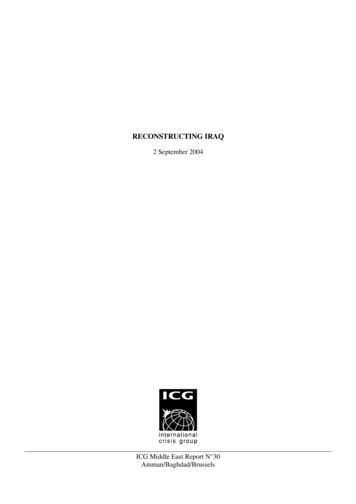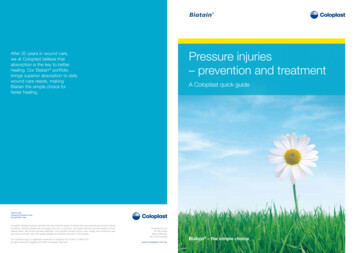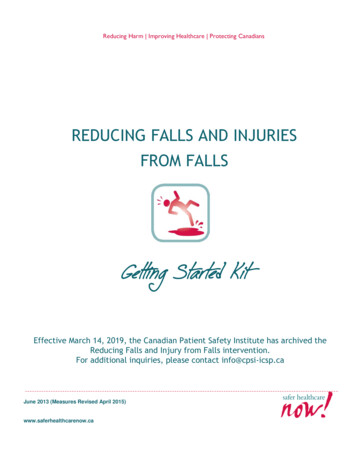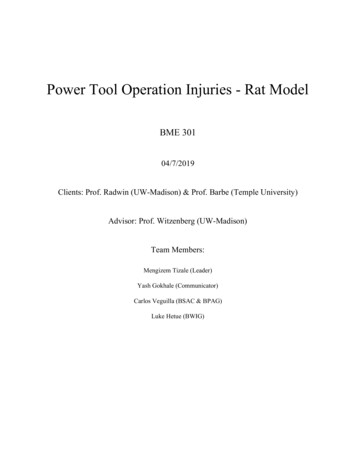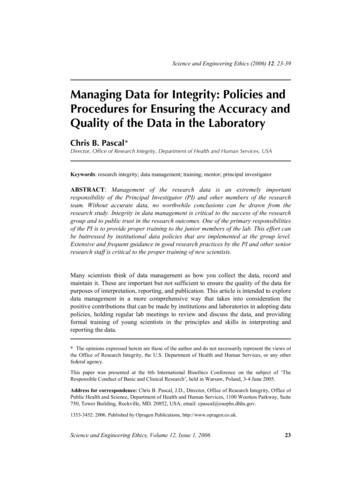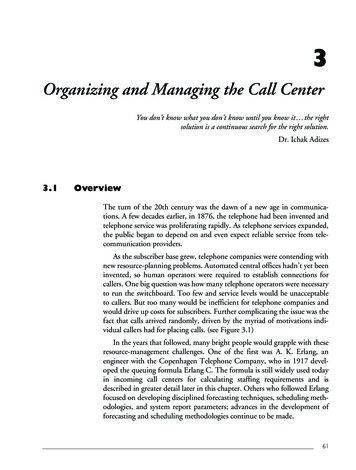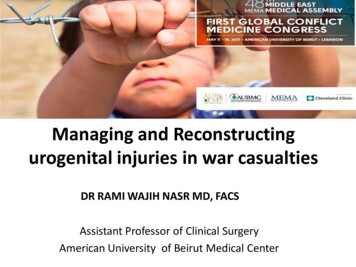
Transcription
Managing and Reconstructingurogenital injuries in war casualtiesDR RAMI WAJIH NASR MD, FACSAssistant Professor of Clinical SurgeryAmerican University of Beirut Medical Center
Outline Introduction. Kidney ,Ureter, Bladder injuries. Genital injuries.
Introduction: During the last decade, the conflicts in the MiddleEast have changed the face of the traditional war. This is evident from the following observations: The adoption of the wholeenemy’s society as a battlefield. The indiscernibility between warand peace. The indistinction between military and civilian,and blitzing off the civilian facilities.Lind W.S, Nightengale K,Schmitt JF (USMC), Sutton JW,Wilson GI.Marine The Changing Face of War: Into the Fourth Generation CorpsGazette . 1989 Oct: 22-26
The unprecedented heavy use of groundimplanted improvised explosive devices (IEDs)has resulted in the frequent occurrence of adevastating combination of: The lower extremity Pelvic Urogenital Abdominal injuries
Three recent wartime trauma experiences suggestthat modern body armor may be protective of:--- GU or abdominal injuries--- Chest injuries However, Gondusky demonstrated that significantrenal trauma necessitating nephrectomy can stilloccur even if protective body armor is worn.Gondusky JS and Reiter MP: Protecting military convoys in Iraq: An examination of battle injuries sustained by a mechanized battalion duringOperation Iraqi Freedom II. Mil Med 2005; 170: 546.
Nowadays of battle wounds: 70% involved the extremities, 10% were to the head and neck, 15% bullets or shell fragments stuck orpenetrated the chest, abdomen or pelvis.Bollet, A. J.: Civil War Medicine, Challenges and Triumphs. Tucson, Arizona: Galen Press, Ltd., pp. 84–86, 2002
Of particular interest is the role of modern bodyarmor in reducing GU injuries. A recent article byPoleg has shown a decreased rate of intra-abdominaland thoracic injuries.Poleg K, Rivkind A, Aharonson-Daniel L and the Israeli Trauma Group: Does body armor protect from firearm injuries? J Am Coll Surg 2006;202: 643.Wettlaufer JN and Weigel JW: Urology in the Vietnam war: Casualty Management and lessons learned. Washington, D. C.: Department of theArmy Medical Department, and Borden Institute 2004.
Injury to GU organs occurs in 0.5% to 4.2% ofall war injuries. In one study by Edmond L. Paquette : Explosive devices (mostly IEDs) wereresponsible for 50% of the injuries. Individual firearms caused 37%. Blunt injury, 13% primarily motor vehicleaccidents.Edmond L. Paquette Genitourinary Trauma at a Combat Support Hospital During Operation Iraqi Freedom: The Impact of BodyArmorTrauma/Reconstruction/Diversion, October 7, 2006.Heidarpour A and Dabbagh A: Therapeutic urogenital modalities during the last three years of the Iran and Iraq war (1985–1987). Mil Med 1999;164: 138.
GU TraumaOIF operative GU wound patterns. Paquette, Paquette2
Urinary Tract Injuries Renal injuries: Penetrating gunshot wounds resulted in22.9% of cases of kidney injury.Always remember that Kidney shot wounds can beoften associated with fatal wounds of the stomach,liver, spleen, diaphragm, intestines or spine.Williams, M. & Jezior, J. Nat. Rev. Urol. 10, 504–512 (2013); published online 23 July 2013
In the management of kidney injuries:---There is a major shift toward nonoperative management of theblunt renal injuries. The non-operative management of highgrades injury, especially during combat, is stillcontroversial; and its concomitant occurrencewith other injuries warrants exploration.Bjurlin MA, Jeng EI, Goble SM, Doherty JC, Merlotti GJ. Comparison of nonoperative management with renorrhaphy and nephrectomy inpenetrating renal injuries. Journal of Trauma and Acute Care Surgery. 2011 Sep 1;71(3):554-8
The reported incidence of nephrectomy in the militaryliterature ranges between 63%-68% especially ifexploration was needed. The goal in the management of renal injury is to fulfill thetrifecta of:--- Hemorrhage control,--- Parenchyma preservation,--- low surgical complications. There are reports of kidney salvage surgery in the combatsetting, such as partial nephrectomy and renorraphy .Hudak SJ, Hakim S. Operative management of wartime genitourinary injuries at Balad Air Force Theater Hospital, 2005 to 2008. The Journal of urology.2009 Jul 31;182(1):180-3.Serkin FB, Soderdahl DW, Hernandez J, Patterson M, Blackbourne L, Wade CE. Combat urologic trauma in US military overseas contingency operations.Journal of Trauma and Acute Care Surgery. 2010 Jul 1;69(1):S175-8.
Figure 1: A 32-year-old young man victim of a stab injury presented with grade IVinjury of the left kidney; the patient was managed expectantly
Complication of conservative management:-- Urinary Extravasation Urinoma is observed in 1-7%after renal injury.-- Delayed Hemorrhage which occurs most commonlyin the first two week after the trauma( 0-25%).-- Renal Insufficiency, The rate of dialysis according tothe data from the National Trauma Data Bank (NTDB)is 0.46 %.-- Urinary fistulas-- Hypertension :Goldblatt's kidney is still the plausibletheory that explains hypertension after renal traumathe highest incidence of hypertension was as high as40%.
Ureteral Injuries Ureteral trauma accounts for less than 1% ofall urologic traumas. The proximal ureter is more often injured in59.7% of the cases . The intimate anatomy of the ureter with otherstructures has made isolated ureteral injuriesimplausible. Concomitant injuries to other organs arenoted in 90.4% of the cases.PRESTI Jr JC, CARROLL PR, McANINCH JW. Ureteral and renal pelvic injuries from external trauma: diagnosis and management. Journal of Trauma and Acute Care Surgery. 1989Mar 1;29(3):370-4.22- Pereira BM, Ogilvie MP, Gomez-Rodriguez JC, Ryan ML, Peña D, Marttos AC, Pizano LR, McKenney MG. A review of ureteral injuries after external trauma. Scand J TraumaResusc Emerg Med. 2010 Feb 3;18(6).
Hematuria is a poor indicator of ureteral injury. A Recent meta-analysis showed that hematuria is presentin only 44% of patients with ureteral injury. In combat injury to the ureter, it may be affected by theblast effect, can become ischemic but is unlikely to cause ofhematuria. The most important step in diagnosing ureteral injury is:1. High clinical suspicion based on the mechanismof injury,2. The trajectory of the missile,3. Intraoperative finding.
Figure 2: A 23-year-old young man sustained a stab injury to his abdomen. Delayed imagesdemonstrate seepage of the contrast through the trajectory of the stab. At the time of exploration, theureter was repaired by an end-to-end anastomosis.
Ureteral injuries can be missed in 38% of thepatients and this has been associated with highmorbidity and mortality. One of the main contributing to this high figure ofmissed injuries is delayed necrosis phenomenaafter blast injuries. The temporary cavity effect associated with theblast injuries may jeopardize the blood supply tothe ureter; this cannot be evident at the time oflaparotomy or initial imaging.Best CD, Petrone P, Buscarini M, Demiray S, Kuncir E, Kimbrell B, Asensio JA. Traumatic ureteral injuries: a single institution experience validating the AmericanAssociation for the Surgery of Trauma-Organ Injury Scale grading scale. The Journal of urology. 2005 Apr 30;173(4):1202-5.
Dr Nasr
The principles of ureteral repair are:-- Adequate ureteric debridement and carefulmobilization,-- Spatulated, tension-free, water-tightanastomosis,-- Adequate drainage of the retroperitoneumand quarantine the anastomosis from otherorgans by omental wrap.Brandes S, Coburn M, Armenakas N, McAninch J. Diagnosis and management of ureteric injury: an evidence‐based analysis. BJU international. 2004 Aug 1;94(3):277Elliott SP, McAninch JW. Ureteral injuries: external and iatrogenic. Urologic Clinics of North America. 2006 Feb 28;33(1):55-66.
In the acute phase, the decision to proceed with theprimary repair of the injured ureter depends on:--- The stability of the patient,--- Presence of other organ injuries, fecalcontamination of the field,--- The extent of the ureteral injury,--- Also, the involvement of the upper andmid ureter in injury may require a complexrepair.Brandes S, Coburn M, Armenakas N, McAninch J. Diagnosis and management of ureteric injury: an evidence‐based analysis. BJU international. 2004 Aug 1;94(3):277Elliott SP, McAninch JW. Ureteral injuries: external and iatrogenic. Urologic Clinics of North America. 2006 Feb 28;33(1):55-66.
In the scenario where the primary repair of theinjured ureter is not feasible:-- The ureter should be ligated andmarked with a radio-opaquesurgical clip, which can help inthe planning of surgical repair.-- The drainage of the kidney can beachieved by inserting a nephrostomytube.Broghammer JA, Hotaling JM. Traumatic Ureteral Injuries. InUrological Emergencies 2013 Jan 1 (pp. 39-53). Humana Press.
Bladder Injury According to The Joint Theater Trauma Registry of allUS military between October 2001 and January2008, bladder injury occurred in 21% of the patients29% of them had concomitant pelvic fractures. This rate is higher than during the Vietnamwar(10%). Every case of pelvic fracture, a workup should bedirected to rule out an associated bladder injury.Serkin FB, Soderdahl DW, Hernandez J, Patterson M, Blackbourne L, Wade CE. Combat urologic trauma in US military overseas contingency operations. Journalof Trauma and Acute Care Surgery. 2010 Jul 1;69(1):S175-8.
There increase use of CT-cystogram to rule outbladder injury especially in :1.Multiple injuries,2.Gunshot for the pelvis,3.Penetrating injuries below the umbilicus ,4.Presences of gross hematuria.CT-Cystogram is more accurate than conventional cystogram,associated with better delineation of the location and extentof the injury, and easiness in imaging interpretation.Ziran BH, Chamberlin E, Shuler FD, Shah M. Delays and difficulties in the diagnosis of lower urologic injuries in the context of pelvic fractures. Journal of Trauma and Acute Care Surgery.2005 Mar 1;58(3):533-7.
bladderExtraperitoneal extravasationcystogramIntraperitoneal extravasationCT cystogram
Intra-op identification of bladder injury can be achieved byinflating the bladder with 300-400cc saline with methyleneblue. Most of the times primary repair of the injury is encouragedand the decision to leave suprapubic catheter is based onsurgeon discernment. The presence of simultaneous rectal injury and bladder injurymake patients more prone for rectovesical fistula and urinomaso omental flap must be put between the two if feasableMaxwell RA, Fabian TC. Current management of colon trauma. World journal of surgery. 2003 Jun 1;27(6):632-9.Crispen PL, Kansas BT, Pieri PG, Fisher C, Gaughan JP, Pathak AS, Mydlo JH, Goldberg AJ. Immediate postoperative complications of combined penetratingrectal and bladder injuries. Journal of Trauma and Acute Care Surgery. 2007 Feb 1;62(2):325-9.
Foley balloon inside the bladderLeak to the woundDr Nasr
Injuries to the External Genitalia External genitalia Injuries compromise 70% of all genitourinaryinjuries.--- The majority of these injuries are caused by highvelocity missiles due to IED (improvised explosivedevices) which result in greater damage than thoseseen in low-velocity gunshot wounds in civilianinjuries.Hudak SJ, Hakim S. Operative management of wartime genitourinary injuries at Balad Air Force Theater Hospital, 2005 to 2008. The Journal of urology. 2009 Jul 31;182(1):180-3.
Penile injuries:Penile injuries during military conflicts are common.--- Up of 50 % of these injuries entail deeper structuresof the penis; explicitly: the urethra and/or corpora . Superficial injuries:---- Superficial injuries of the penile skin are usuallydebrided and irrigated and then closed in a delayed fashioneither primarily or using skin grafts.Delayed necrosis of the penis after primary repair of high velocity tothe penis has been reported, and the consequences can bedevastated.Owens BD, Kragh Jr JF, Wenke JC, Macaitis J, Wade CE, Holcomb JB. Combat wounds in operation Iraqi Freedom and operation Enduring Freedom. Journal of Trauma and AcuteCare Surgery. 2008 Feb 1;64(2):295-9.
For corporal injuries, debridement, irrigation and monitoringfor tissue necrosis are needed which might necessitatemultiple visits to the operating room. Extensive loss ofcorporal tissue might need fasciocutaneos or myocutaneousflaps.Morris SF, Tang M, Almutari K, Geddes C, Yang D. The anatomic basis of perforator flaps. Clinics in plastic surgery. 2010 Oct 31;37(4):553-70.
Urethral injuries : Are rare comprising 0.8% of patients with combatrelated genital injuries. Frequently the anterior urethral injury is associatedwith other external genitalia injuries. Here the rule of staged reconstruction also applies ifthere is extensive penile or perineal tissue loss. The majority of the patients require compositereconstruction with buccal mucosal or skin graft as a firststage repair to be followed by a second stage urethroplastyafter three months especially if the defect is more than 1.5cm in the anterior urethra.Serkin FB, Soderdahl DW, Hernandez J, Patterson M, Blackbourne L, Wade CE. Combat urologic trauma in US military overseas contingency operations. Journal of Trauma and AcuteCare Surgery. 2010 Jul 1;69(1):S175-8.Summerton DJ, Djakovic N, Kitrey ND, Kuehhas F, Lumen N, Serafetinidis E, Sharma DM. Guidelines on urological trauma. Eur Urol. 2014.
Dr Nasr
In the case of glans involvement in penile injury,special consideration should be given to theaesthetic aspect of the planned repair. In injuries that involve less than 50% of theglans, a primary closure can be attempted. However, in injuries with a significant loss of theglans, staged repair of the glans with skin orbuccal mucosa grafting of the defect is advisable,or one of the noval reconstructive techniques.Williams M, Jezior J. Management of combat-related urological trauma in the modern era. Nature Reviews Urology. 2013 Sep 1;10(9):504-12.
Scrotal and testicular injury The incidences of the scrotal and testicular injuries havesoared up in the modern conflicts, and this can be attributedto the use of IED and unavailability of genital protector inmost of the body armors. All scrotal military injuries need to be explored because evena tiny laceration can mask an occult testicular rupture. The testis salvage rate is 75% of scrotal injury and 50% oftestis rupture and these figures are comparable to whatobserved in a low-velocity gunshot.Gawande A. Casualties of war—military care for the wounded from Iraq and Afghanistan. New England Journal of Medicine. 2004 Dec 9;351(24):2471-5.Brandes SB, Buckman RF, Chelsky MJ, Hanno PM. External genitalia gunshot wounds: a ten-year experience with fifty-six cases. Journal of Trauma and Acute CareSurgery. 1995 Aug 1;39(2):266-72.
Superficial scrotal injuries are treated with:--- Debridement of the devitalized tissues andirrigation of the wounds,--- loose approximation of the edges with theinsertion of drains and application of vacuumdevices to the area. Testicular rupture necessitates:--- Debridement and closure of the tunica albugineato preserve the testis for fertility and testosteroneproduction.--- If primary tunical repair is not feasible, then atunica vaginalis graft can be used to close thedefect.Kapoor D, Leech J, Yap W. Use of tunica vaginalis patch graft for repair of traumatic testicular rupture. Urology. 1992 Oct 31;40(4):374-5.Yap SA, DeLair SM, Ellison LM. Novel technique for testicular salvage after combat-related genitourinary injury. Urology. 2006 Oct 31;68(4):890-e11.Jones GH, Kirkman-Brown J, Sharma DM, Bowley D. Traumatic andropause after combat injury. BMJ case reports. 2015 Aug 28;2015:bcr2014207924.
Recently, an approximation of both testicles to each othercreating one single function testis has been described.(Yapet. al.)Yap SA, DeLair SM, Ellison LM. Novel technique for testicular salvage after combat-related genitourinary injury. Urology. 2006 Oct 31;68(4):890-e11.
Acute androgen deficiency in the setting oftrauma has been described, and thesymptoms can be confused with sepsis. Main symptoms are intermittent fever,sweating and hot flushes. This is why always avoid orchiectomy ifpossible.Jones GH, Kirkman-Brown J, Sharma DM, Bowley D. Traumatic andropause after combat injury. BMJ case reports. 2015 Aug28;2015:bcr2014207924 .
Those with extensive soft tissue loss seen due toblast and high-velocity injuries necessitatedstaged genital reconstruction with a reoperationrate of 44%. The skin grafts used are of 0.014-0.016 splitthickness unmeshed skin grafts. The graft is laid down after ensuring a maturegraft bed and stabilized using a vacuum-assistedclosure device at a pressure of 80 mmHg.Paquette EL. Genitourinary trauma at a combat support hospital during Operation Iraqi Freedom: the impact of body armor. The Journal of urology. 2007 Jun 30;177(6):2196-9.Senchenkov A, Knoetgen J, Chrouser KL, Nehra A. Application of vacuum-assisted closure dressing in penile skin graft reconstruction. Urology. 2006 Feb 28;67(2):416Black PC, Friedrich JB, Engrav LH, Wessells H. Meshed unexpanded split-thickness skin grafting for reconstruction of penile skin loss. The Journal of urology. 2004 Sep30;172(3):976-9.
Dr Nasr
Distal urethraProximal urethraDr NasrCord and epididymis
Placement of vacuum assisted closure device.Adopted from Steven J. et al
Dr Nasr
Dr Nasr
Conclusion Most GU trauma noted during OIF involves the lower GU tract.Most Uro-genital trauma, predominantly from IED blast injury,requires complex and often staged reconstructive procedures. Despite battlefield conditions and a high rate of multisystem injuryan organ salvage rate comparable to that in civilian series isattainable. For a casualty with a renal injury who goes to the OR, there was a71% nephrectomy rate. As recently noted by Waxman et al., the incidence of battlefield GUinjuries warrants deploying general surgeons who receive a reviewof the management of GU injuries as part of their predeploymenttraining.
In one study by Edmond L. Paquette : Explosive devices (mostly IEDs) were responsible for 50% of the injuries. Individual firearms caused 37%. Blunt injury, 13% primarily motor vehicle accidents. Heidarpour A and Dabbagh A: Therapeut
